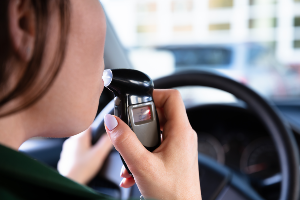
In-car breathalyzers, known as ignition interlock devices (IIDs), have been used throughout the U.S. for years. Over the last decade, the use of these ignition interlock devices has tripled, according to an investigation by the New York Times. Drivers who have an IID installed in their vehicles are often required to blow into the device while simultaneously operating their vehicles, a measure specifically designed to prevent drunk driving offenders from starting their cars while intoxicated. This form of distraction, similar to using a cell phone while driving, has led to an alarming number of IID-related crashes. While IIDs are increasingly imposed after drunk driving convictions in Pennsylvania and throughout the U.S., few people weigh the consequences of how they distract drivers.
IIDs are extremely popular with law enforcement due to the figures that demonstrate that these devices work. A 2016 study at the University of Pennsylvania shows that IIDs have reduced drunk driving deaths by 15%. But those breath checks while driving come with a harsh adverse effect: They are leading to distracted driving accidents, several of which have been deadly.
How Do Ignition Interlock Devices Work?
IIDs require drivers to blow into the in-car breathalyzer to ensure they haven’t been drinking before starting the vehicle. The potential trouble arises when drivers are required to do “rolling retests” or prove they’re still sober while operating their cars. For certain drivers, having an ignition interlock device installed is a legal requirement, ensuring they comply with specific legal mandates after a driving offense. These breath tests that are expected mid-drive are designed to prevent a driver from having a friend blow into their IID to start their car, then driving off while inebriated.
Signaled by a beep, the driver has a couple of minutes to pick up the handset and blow into it again. If the driver fails to do so in the allotted time, the car will begin flashing the headlights and honking the horn, but it will not interfere with the car’s operation.
To reset the device to shut off the horn and blinking headlights, the driver must:
- Stop their vehicle
- Wait for the lockout period to pass
- Retest their breath for alcohol
It’s crucial to adhere to the ignition interlock program’s requirements for the device’s safe and compliant operation. Keep in mind that each state has different regulations on how often rolling retests are required.
What Is the Potential Problem in Using IIDs?
There’s a difference of opinion between what the National Highway Traffic Safety Administration (NHTSA) and companies that sell IIDs consider safe when taking rolling retests. According to the NHTSA, drivers are urged to pull off the road to a secure location before taking rolling retests to avoid distracted driving, emphasizing the importance of adhering to ignition interlock requirements for safety. On the other hand, IID companies claim their ignition interlock tests are safe to perform while driving a vehicle. One brand, LifeSafer Ignition Interlock, claims:
“There is time (determined by state regulation, but usually between 3 and 5 minutes) between the alert and the need to test for you to pull safely off the road and test. There is no need to look at the device while testing.”
The underlying problem is that drivers don’t need to look at the device while testing, so they feel confident taking the breath test while driving, leading to a growing number of accidents caused by distracted driving. The New York Times uncovered dozens of accident reports and lawsuits related to crashes caused by people in the process of performing a rolling retest.
The Times also noted how the number of installed IIDs grew immensely, from 133,000 to 350,000 over the past decade. Despite the reports signaling the risk of distracted driving while performing a rolling retest, the number of installed IIDs is expected to rise over the next few years. It’s crucial to rely on a certified ignition interlock provider for not only the installation but also for comprehensive instructions and support on conducting rolling retests safely.
Anti–Drunk Driving Advocates Say There’s No Comparison
Despite the NHTSA stating in 2010 that the agency does not expect drivers to do rolling retests while operating their vehicles, the Times report shows that the industry effectively avoided making drivers pull over, asserting it was impractical.
There are many advocates for IIDs, including Mothers Against Drunk Driving, the interlock industry, and other agencies, all pushing to install ignition interlock devices as a preventive measure against drunk driving. The Centers for Diseases Control and Prevention (CDC) touts the benefits of IIDs, claiming they:
“Reduce repeat offenses for driving while intoxicated (DWI) by about 70 percent while they are installed.”
Ignition interlocks have proven to be effective in decreasing repeat DWI offenses, underscoring their importance in the fight against drunk driving. The numbers show that IIDs play an active role in reducing the number of re-offending drunk drivers, but that is little consolation to the victims injured in distracted driving collisions.
Retain an Experienced Pennsylvania Car Accident Attorney Ready to Fight for Your Recovery
If you’ve been injured in a car accident caused by a distracted driver, don’t wait to consult with an experienced personal injury attorney. The injury legal team at Rubin, Glickman, Steinberg & Gifford P.C. is prepared to handle the complex, time-consuming task of securing financial recovery for car accident victims in Montgomery County and across Pennsylvania.
With 270 cumulative years of legal experience in a wide range of complex cases, we have won multi-millions for car accident victims throughout Southeastern Pennsylvania. To schedule a free consultation with a seasoned personal injury lawyer, complete a contact form or call 215-688-5915.










